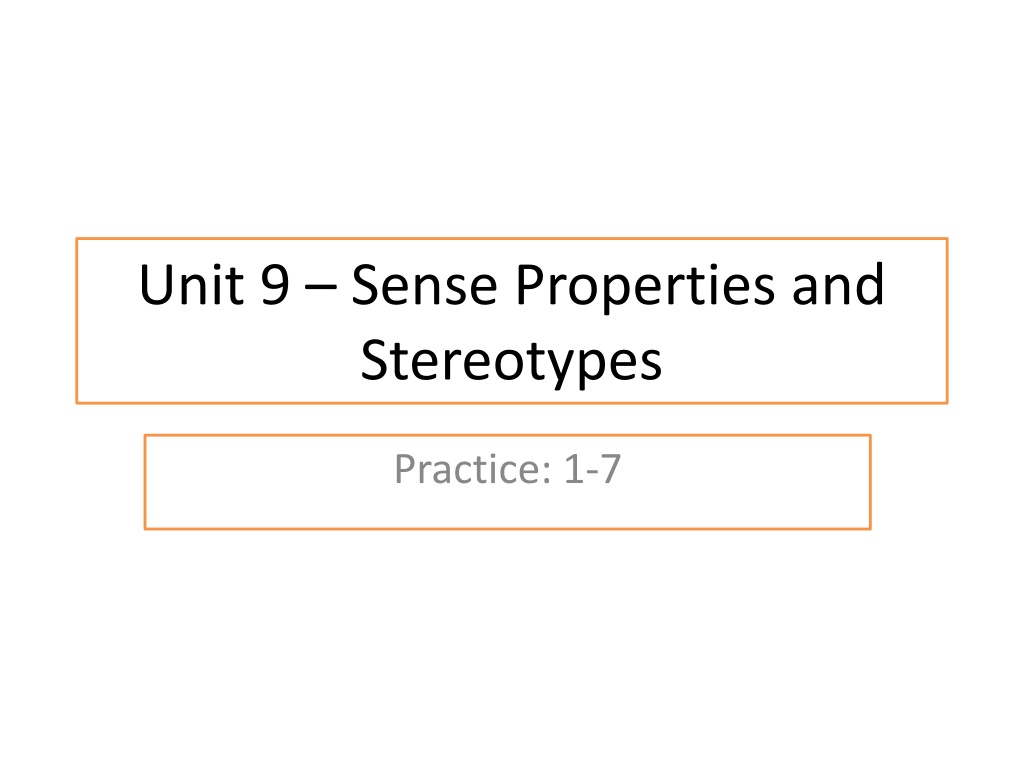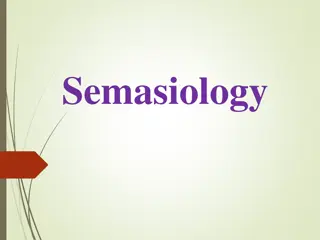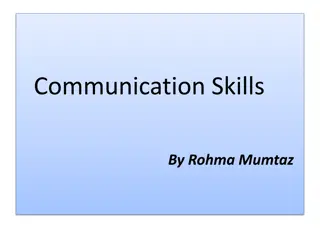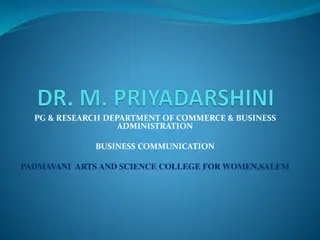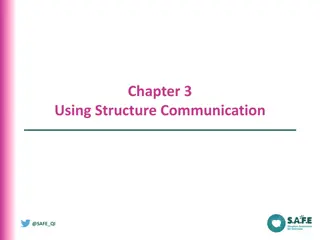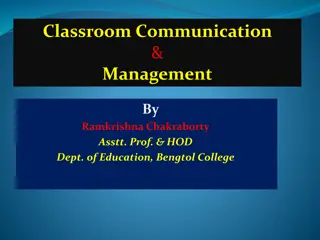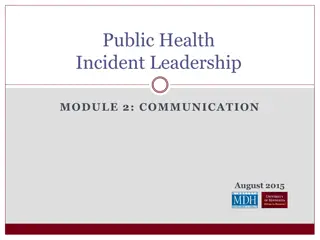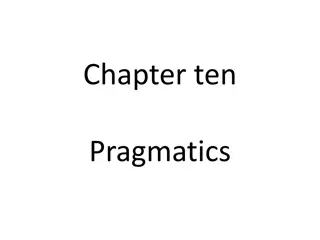Understanding Meaning and Communication
Diving into the nuances of language and communication, this content explores concepts like two-place predicates, referents, and hard cores of meaning. It delves into the challenges of distinguishing between factual and semantic questions and emphasizes the importance of agreeing on word meanings for effective communication.
Download Presentation

Please find below an Image/Link to download the presentation.
The content on the website is provided AS IS for your information and personal use only. It may not be sold, licensed, or shared on other websites without obtaining consent from the author. Download presentation by click this link. If you encounter any issues during the download, it is possible that the publisher has removed the file from their server.
E N D
Presentation Transcript
Unit 9 Sense Properties and Stereotypes Practice: 1-7
Quick Quiz 1. Which of the following are two-place predicates? Below, Smother, Sleep, Come, Annihilate, Vanish, Afraid (of). 2. Use these terms correctly to fill in the blanks: Referent, Extension, Prototype . A _________is the thing being referred to on a particular occasion of an utterance. __________is a set of things that could be referred to using a particular predicate. A thing typically referred to using a particular predicate is a ___________.
It is some times difficult to distinguish between a factual question (ontological) and semantic one (? of meaning). (1) Have you ever been asked an apparently factual question about something (call it 'X'), and found it necessary to say to your questioner "Well, it depends on what you mean by X ? Yes / No (2) Have you ever been involved in an argument with someone over an apparently factual matter, only to discover that some particularly crucial word in the argument had a different meaning for the other person? Yes / No 3) In a case where someone says, "Well, it depends what you mean by X", is it often possible, once the meaning of X has been agreed by both parties, for the original factual question to be answered straight forwardly? (4) If two people can be said to agree on the meanings of all the words they use, must any remaining disagreements between them be regarded as disagreements about matters of fact? Yes / No (5) If we could not agree about the meanings of any of the words we use, could any disagreement about matters of fact even be formulated, let alone resolved? Yes / No Yes / No
An indispensible hard core of meaning In order to be able to talk meaningfully about anything, it is necessary to agree on the meanings of the words involved. This is a truism. In everyday life, people reach practical agreement on the meanings of almost all the words they use, and effective and successful communication takes place as a result. If a person wants to hinder or obstruct communication, he can begin to quibble over the meanings of everyday words. Although there may be disagreement about the fine details of the meanings of words 'around the edges', we find in the everyday use of language that all words are understood by speakers as having an indispensable hard core of meaning.
What word is Speaker B defining in an unusual way? (1) A: "I saw" something strange in the garden this morning." B: "Oh! What was it?" A: "An animal perched on top of the clothes pole. B: "How do you know it was an animal?" A: "I saw it. It was a cat." B: "You might have seen a cat, but how can you be sure it was an animal?" A: "Well, of course it was an animal, if it was a cat." B: "I don't see how that follows." (2)B: "My neighbor's child is an adult." A: "You mean he was a child and is now grown up?" B:"No. He is still a child, even though he's an adult." A: "You mean that he's a child who acts in a very grown up way?" B: "No. He's just an adult child, that's all." 3)B: "I finally killed Ben's parrot." A: "So it's dead, then?" B: "No, I didn't say that. Just that I killed it." A: "But if you killed it, it must be dead." B: "No. I was quite careful about it. I killed it very carefully so it's not dead."
Word or Sentence Meaning NOT Speaker Meaning is called Sense The SENSE of an expression is its indispensable hard core of meaning. This definition deliberately excludes any influence of context or situation of utterance on the senses expressions. (Thus it is problematic to talk of the senses of deictic words (Unit 7), but we will not go into that problem here.) The sense of an expression can be thought of as the sum of its sense properties and sense relations with other expressions. For the moment, we will concentrate on three important sense properties of sentences, the properties of being analytic, of being synthetic, and of being contradictory .
An ANALYTIC sentence is one that is necessarily TRUE, as a result of the senses of the words in it. An analytic sentence, therefore, reflects a tacit agreement by speakers of the language about the senses of the words in it. A SYNTHETIC sentence is one which is NOT analytic, but may be either true or false, depending on the way the world is. Analytic: All elephants are animals The truth of the sentence follows from the senses of elephant and animal. Synthetic: John is from Ireland There is nothing in the senses of John or Ireland or from which makes this necessarily true or false.
(1) Label the following sentences either T for true, F for false, or D for don't know, as appropriate. (a) Cats are animals (b) Bachelors are unmarried (c) Cats never live more than 20 years (d) Bachelors cannot form lasting relationships T / F / D (e) Cats are not vegetables T / F / D (f) Bachelors are male T / F / D (g) No cat likes to bathe T / F / D (h) Bachelors are lonely T / F / D (2) Were you able to assign T or F to all the above sentences? (3) Which of the above sentences do you think ANY speaker of English could assign T or F to? (4) Which of the sentences in (a)- (h) above would you say are true by virtue of the senses of the words in them? (5) Which of the sentences above would you say might be true or false as a matter of fact about the world? T / F / D T / F / D T / F / D Yes / No
Here are some more sentences. Circle A for analytic, or S for synthetic, as appropriate. For some, you will have to imagine relevant situations. (1) John's brother is nine years old (2) John s nine-year-old brother is a boy A/S (3) Sam's wife is married (4) Sam s wife is not German (5) My watch is slow (6) My watch is a device for telling the time A/S Analytic sentences are always true (necessarily so, by virtue of the senses of the words in them) Synthetic sentences can be sometimes true, sometimes false, depending on the circumstances. A/S A/S A/S A/S
We now come to Contradiction. A CONTRADICTION is a sentence that is necessarily FALSE, as a result of the senses of the words in it. Thus a contradiction is in a way the opposite of an analytic sentence. This animal is a vegetable is a contradiction. This must be false because of the senses of animal and vegetable. Both of John s parents are married to aunts of mine is a contradiction. This must be false because of the senses of both parents, married and aunt.
Circle the following sentences A for analytic, S for synthetic or C for contradiction, as appropriate. For some you will have to imagine relevant situations. (1) That girl is her own mother s mother (2) (2) The boy is his own father s son (3) Alice is Ken's sister (4) Some typewriters are dusty (5) If it breaks, it breaks. (6) John killed Bill, who remained alive for many years after Analytic sentences can be formed from contradictions, and vice versa, by the insertion or removal, as appropriate, of the negative particle word not.
We pay no attention here to the figurative use of both analytic sentences and contradictions. Taken literally, the sentence That man is not a human being is a contradiction. This very fact is what gives it its power to communicate a strong emotional judgment (stronger than, say, the synthetic That man is very cruel. We will now mention a limitation of the notions analytic, synthetic and contradiction. Remember that these notions are defined in terms of truth. Imperative and interrogative sentences cannot be true or false, and so they cannot be analytic (because they cannot be true), or synthetic, because 'synthetic' only makes sense in contrast to the notion analytic . You will have noticed that synthetic sentences are potentially informative in real-world situations, whereas analytic sentences and contradictions are not informative to anyone who already knows the meaning of the words in them. It might be thought that the fact that semanticists concentrate attention on unusual sentences, such as analytic ones and contradictions, reflects, a lack of interest in ordinary, everyday language. Quite the contrary! Semanticists are interested in the foundations of everyday communication. People can only communicate meaningfully about everyday matters, using informative synthetic sentences, because (or to the extent that) they agree on the meanings of the words in them. This basic agreement on meaning is reflected in analytic sentences, which is what makes them of great interest to semanticists. The notions analytic, synthetic, and contradiction each apply to individual sentences. Analyticity, syntheticity, and contradiction are then, sense properties of sentences.
That man is human has the sense property of analyticity (or of being analytic). That man is tall has the sense property of syntheticity (or of being synthetic). That man is a woman has the sense property of being a contradiction. (1) Does the analyticity of That man is human depend in some crucial way on a semantic relationship between the sense of man and that of human? Yes I No (2) Which of the following statements seems to express this semantic relationship, between man and human correctly? Circle your choice. (a) The sense of man includes the sense of human. (b) The sense of human includes the sense of man. (c)The sense of man is identical to the sense of human. (3) Does, the semantic relationship that exists between man and human also exist between man and tall? (4)Does the absence of this semantic relationship between man and tall account for the fact that This man is tall is not analytic, like This man is human? Yes / No Yes I No
Note the interdependence of sense relations and sense properties. Sense properties of sentences (e.g. analyticity) depend on the sense properties of, and the sense relations between, the words they contain. The sense relation between the predicates man and human is known as hyponymy. The sense relation between the predicates man and woman is a kind of antonymy. The sense structure of a language is like a network, in which the senses of all elements are, directly or indirectly, related to the senses of all other elements.
For the rest of this unit, we will explore a limitation in the idea of sense, a limitation which is quite parallel to a limitation in the idea of extension, pointed out in the previous unit (Unit 8). For convenience, we repeat below our statement of the relationship usually envisaged between sense and extension. A speaker's knowledge of the sense of a predicate provides him with an idea of its extension. For example, the 'dictionary definition which the speaker accepts for cat can be used to decide what is a, cat, and what is not: thus defining, implicitly, the set of all cats. Now we'll consider the implications of this envisaged relationship more closely. We need to recognize the concepts of necessary and sufficient conditions.
A NECESSARY CONDITION on the sense of a predicate is a condition (or criterion) which a thing MUST meet in order to qualify as being correctly described by that predicate. A SUFFICIENT SET OF CONDITIONS on the sense of a predicate is a set of conditions (or criteria) which, if they are met by a thing, are enough in themselves to GUARANTEE that the predicate correctly describes that thing. Take the predicate square, as usually understood in geometry. 'Four- sided is a necessary condition for this predicate, since for anything to be a square, it must be four-sided. 'Plane figure, four-sided, equal-sided and containing right angles' is a sufficient set of conditions for the predicate square, since if anything meets all of these conditions, it is guaranteed to be a square. 'Four-sided and containing right angles' is not a sufficient set of conditions for square. Many non-square shapes meet these conditions. 'Three-sided' is not a necessary condition for square.
Practice 6 1. Is 'three-dimensional object' a necessary condition for the predicate sphere? 2. Is 'three-dimensional object' a necessary condition for the predicate circle? Yes / No Yes / No 3. Is 'three-dimensional object and circular in cross-section a sufficient set of conditions for sphere? 4. Is 'three-dimensional object and with all points on surface equidistant from a single point' a sufficient set of conditions for sphere? Yes / No 5. Is 'male' a necessary condition for bachelor? 6. Is 'adult, male, human, and unmarried' a sufficient set of conditions for bachelor? Yes / No Yes / No Yes / No
Obviously, we are stating conditions on predicates in terms of other predicates in the language. Henceforth, we will drop the quotation marks, and envisage necessary and sufficient conditions as relationships between predicates. Thus we shall say, for example, that animal and cat are semantically related in such a way that the applicability of the former is a necessary condition for the applicability of the latter. (Nothing can be a cat without being an animal.) In fact it is possible to give complete definitions of some predicates in the form of a 'necessary and sufficient list' of other predicates. Kinship predicates and shape predicates are well-known examples. (l) Is father adequately defined as male parent? Yes / No (2) Is female spouse an adequate definition of wife? Yes / No (3) Is parent s father an adequate definition of grandfather? Yes / No (4) Is hexagon adequately defined as five-sided plane figure? Yes / No
The idea of defining predicates by sets of necessary and sufficient conditions can be evaluated from a practical point of view. The parallel with the undecidability of extensions is very close. Just as in a large number of cases it is implausible to postulate the existence of perfectly clearly defined sets of things, such as the set of all cats, the set of all tables, etc., so too the idea that there could be satisfactory definitions in the form of sets of necessary and sufficient conditions for such predicates as cat, table, etc. is clearly misguided. One of the best known arguments (by the philosopher Ludwig Wittgenstein) against the idea that definitions of the meanings of words can be given in the form of sets of necessary and sufficient conditions involves the word game.
Given below are two definitions of the word game, taken from dictionaries of modern English. For each definition, give (a) the name of at least one game (e.g. football, chess) not covered by the definition, and (b) at least one thing that is not a game (e.g. piano-playing, watching television) but which falls within the given definition. (1)An amusement or diversion a) ________________(b) ________________ (2) A contest, physical or mental, according to set rules, undertaken for amusement or for a stake (a)__________________(b)________________
Wittgensteins example of game cuts both ways. On the one hand, one must admit that a set of necessary and sufficient conditions for game to cover all eventualities (including games played in the past and games yet to, be-invented) cannot be given. On the other hand, one has to admit that some of the definitions offered by dictionaries, while imperfect, do cover a large number of cases, and are in fact helpful. It is possible to give at least some necessary and/or sufficient conditions for all predicates in a language. If there were a predicate for which we could give no necessary or sufficient condition, we would have to admit that we literally had no idea what it meant. (l) Is the sense of activity a necessary part of the sense of game (i.e. must something be an activity to be a game)? Yes / No (2) Is the sense of game a necessary part of the sense of tennis (i.e. must some activity be a game to be tennis)? Yes / No
(3) Is the sense of chess a sufficient part of the sense of game (i.e. is the fact that something is chess sufficient evidence to call it a game)? Yes / No (4) A witty literary lady coined the memorable sentence, A rose is a rose is a rose, implying that definition could go no further. One can actually go at least a little further. Is the sense of flower a necessary part of the sense of rose? Yes / No Except in a few cases, complete definitions of the meanings of predicates cannot be given, but nevertheless it is possible to give, for every predicate in a language, at least some necessary and/or sufficient ingredients in its meaning.
It seems reasonable to suppose that speakers of a language have in their heads not only an idea of the bare sense of any given predicate, but also a stereotype of it. The STEREOTYPE of a predicate is a list of the TYPICAL characteristics of things to which the predicate may be applied. The stereotype of cat would be something like: Quadruped, domesticated, either black, or white, or grey, or tortoise-shell, or marmalade in color, or some combination of these colors, adult specimens about 50 cm long from nose to tip of tail, furry, with sharp retractable claws, etc. etc.
{l) Suggest four characteristics which should be included in the stereotype of the predicate elephant. (Be sure not to include any more basic term, properly belonging to the SENSE of elephant.) (2) Give two characteristics which should be included in the stereotype of mother. (3) Give four characteristics which should be included in the stereotype of cup. (4) Give four characteristics which should be included in the stereotype of building.
A stereotype is related to a prototype (see previous unit) but is not the same thing. A prototype of elephant is some actual elephant, whereas the stereotype of elephant is a list of characteristics which describes the prototype. The stereotype of a predicate may often specify a range of possibilities (e.g. the range of colors of typical cats), but an individual prototype of this predicate will necessarily take some particular place within this range (e.g. black). Another important difference between prototype and stereotype is that a speaker may well know a stereotype for some predicate, such as ghost, witchdoctor, flying saucer, but not actually be acquainted with any prototypes of it. Stereotypes of expressions for things learned about at second hand, through descriptions rather than direct experience, are generally known in this way.
The relationships between stereotype, prototype, sense and extension are-summarized very briefly in the chart. Thing, or set of things, specified Abstract Specification Pertaining to all examples: EXTENTION SENSE Pertaining to typical examples: PROTOTYPE STEREOTYPE The notions of prototype and stereotype are relatively recent in semantics.
The sense of an expression can be thought of as the sum of its sense properties and sense relations. Sense properties of sentences include those of being analytic, synthetic and a contradiction. With the exception of a few predicates such as bachelor, father, square, sphere, etc. it is not possible to give complete definitions of the sense of most predicates by sets of necessary and sufficient conditions. Stereotypes defined in terms of typical characteristics account for the fact that people usually agree on the meanings of the words they use.
Assignment for next class Unit 10 Sense Relations Practices: 1-5 Bonus Assignment due: D (25-11-12) C (26-11-12) Review for Mid. 2 Sun. and Mon. (Dec. 2&3) Mid. 2 Wednesday, Dec. 5 in class (Chps. 4,5,6)
